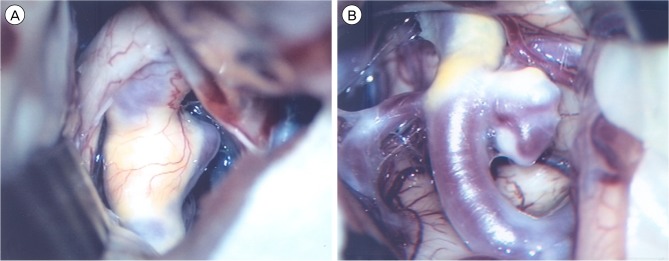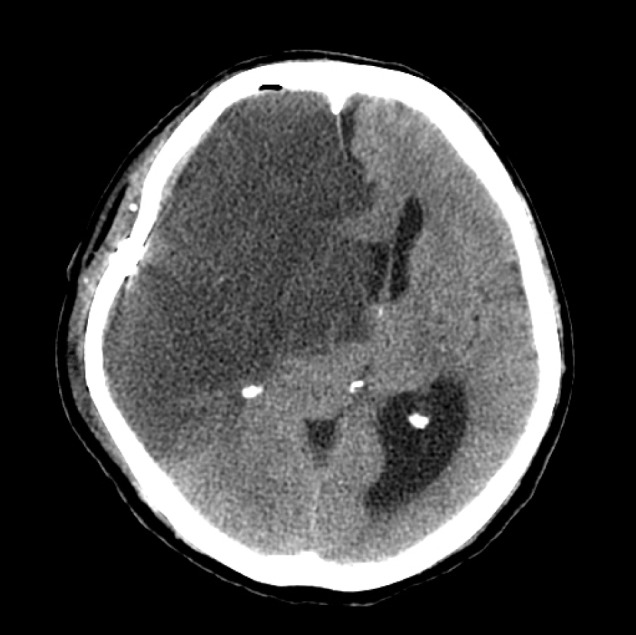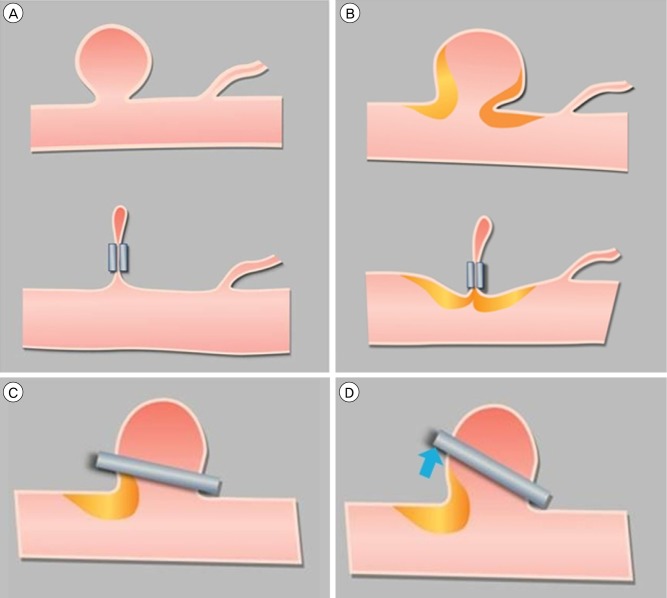J Cerebrovasc Endovasc Neurosurg.
2014 Sep;16(3):247-253. 10.7461/jcen.2014.16.3.247.
Clinical Analysis and Surgical Considerations of Atherosclerotic Cerebral Aneurysms: Experience of a Single Center
- Affiliations
-
- 1Department of Neurosurgery, KyungHee University Hospital, Seoul, Korea.
- 2Department of Neurosurgery, KyungHee University Hospital at Gangdong, Seoul, Korea. realeponym@hanmail.net
- KMID: 1963163
- DOI: http://doi.org/10.7461/jcen.2014.16.3.247
Abstract
OBJECTIVE
Atherosclerotic cerebral aneurysms are known to increase occurrence of thromboembolic events and occlusion of perforator vessels intraoperatively due to pathological changes in the vessels themselves. In the current study, we analyzed the points to be considered during surgery for atherosclerotic cerebral aneurysms and the postoperative results.
MATERIALS AND METHODS
We retrospectively reviewed the medical records, radiological results, and surgical records, including intraoperative video recordings and photographs, of 262 patients who underwent cerebral aneurysm surgery. We then performed a detailed analysis of aneurysm features, surgical methods, and clinical outcomes.
RESULTS
Among 278 aneurysms in 262 patients, 73 aneurysms in 67 patients showed atherosclerotic features (atherosclerotic group, AG), and 205 aneurysms in 195 patients showed no evidence of atherosclerosis (non-atherosclerotic group, NAG). In the AG, clipping with multiple permanent clips was performed in 14 aneurysms, and clip slippage was found in four cases. Six AG cases had a remnant neck after clipping, which was significantly more frequent than in the NAG (p < 0.05). Clinical outcomes and surgery-related complications did not differ significantly between the two groups.
CONCLUSION
In the surgical repair of aneurysms, the incidence of ischemia, which is irreversible or severe, might be greater in atherosclerotic than in non-atherosclerotic aneurysms. In addition, multiple clips might be applied to atherosclerotic aneurysms for effective obliteration and an aneurysm neck might be left to avoid a region of atheroma.
MeSH Terms
Figure
Cited by 2 articles
-
Discrepancy between Angiography and Operative Findings of Small Side Wall Aneurysms in Atherosclerotic Parent Arteries
Sook Young Sim
J Cerebrovasc Endovasc Neurosurg. 2017;19(1):44-47. doi: 10.7461/jcen.2017.19.1.44.Incomplete Clipping Resulting from Scissoring of the Clip Blades during Treatment of a Large Atheromatous Aneurysm
Jin Seong Kim, Seung Hwan Lee, Hak Cheol Ko, Hee Sup Shin, Jun Seok Koh
J Cerebrovasc Endovasc Neurosurg. 2016;18(3):281-285. doi: 10.7461/jcen.2016.18.3.281.
Reference
-
1. Bendszus M, Stoll G. Silent cerebral ischaemia: hidden fingerprints of invasive medical procedures. Lancet Neurol. 2006; 4. 5(4):364–372. PMID: 16545753.
Article2. Carvi y Nievas MN, Hollerhage HG. Risk of intraoperative aneurysm clip slippage: a new experience with titanium clips. J Neurosurg. 2000; 3. 92(3):478–480. PMID: 10701539.
Article3. Flamm ES, Grigorian AA, Marcovici A. Multifactorial analysis of surgical outcome in patients with unruptured middle cerebral artery aneurysms. Ann Surg. 2000; 10. 232(4):570–575. PMID: 10998655.
Article4. Grigorian AA, Marcovici A, Flamm ES. Intraoperative factors associated with surgical outcome in patients with unruptured cerebral aneurysms: the experience of a single surgeon. J Neurosurg. 2003; 9. 99(3):452–457. PMID: 12959429.
Article5. Hadeishi H, Yasui N, Suzuki A. [Risks of surgical treatment for unruptured intracranial aneurysms]. No Shinkei Geka. 1991; 10. 19(10):945–949. Japanese. PMID: 1944779.6. King JT Jr, Berlin JA, Flamm ES. Morbidity and mortality from elective surgery for asymptomatic, unruptured, intracranial aneurysms: a meta-analysis. J Neurosurg. 1994; 12. 81(6):837–842. PMID: 7965113.
Article7. Lindholt JS. Aneurysmal wall calcification predicts natural history of small abdominal aortic aneurysms. Atherosclerosis. 2008; 4. 197(2):673–678. PMID: 17442319.
Article8. Ohno K, Arai T, Isotani E, Nariai T, Hirakawa K. Ischaemic complication following obliteration of unruptured cerebral aneurysms with atherosclerotic or calcified neck. Acta Neurochir (Wien). 1999; 7. 141(7):699–705. discussion 705-6. PMID: 10481780.
Article9. Szelenyi A, Beck J, Strametz R, Blasel S, Oszvald A, Raabe A, et al. Is the surgical repair of unruptured atherosclerotic aneurysms at a higher risk of intraoperative ischemia? Clin Neurol Neurosurg. 2011; 2. 113(2):129–135. PMID: 21095056.
- Full Text Links
- Actions
-
Cited
- CITED
-
- Close
- Share
- Similar articles
-
- Recent Trends in the Treatment of Cerebral Aneurysms: Comparison between Endovascular Coil Embolization and Surgical Clipping
- Surgical Treatment of Unruptured Cerebral Aneurysms
- Surgical Management of Multiple Aneurysms Including Distal Anterior Cerebral Artery Aneurysms
- Direction of Middle Cerebral Artery Bifurcation Aneurysms and Surgical Approach
- New Pathophysiological Considerations on Cerebral Aneurysms




